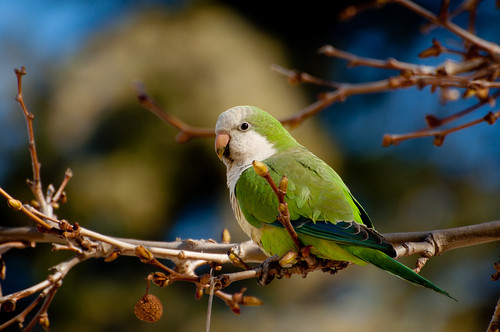Free birds
 Sunday, December 30, 2012 at 2:49
Sunday, December 30, 2012 at 2:49  Despite the fact proper structures have been built for them, the wild Quaker parrots continue to make their own nests in trees near Brooklyn College and in the steeple of Green-Wood Cemetery. Image by JRxpoLook, up in the sky! It’s a bird, it’s . . . hey, it is a bird, a parrot no less — in January! The Quaker parrots or monk parakeets, as they’re known, haven’t just lived in New York for decades, they survived Hurricane Sandy and are now ready to outlast a sub-zero winter.
Despite the fact proper structures have been built for them, the wild Quaker parrots continue to make their own nests in trees near Brooklyn College and in the steeple of Green-Wood Cemetery. Image by JRxpoLook, up in the sky! It’s a bird, it’s . . . hey, it is a bird, a parrot no less — in January! The Quaker parrots or monk parakeets, as they’re known, haven’t just lived in New York for decades, they survived Hurricane Sandy and are now ready to outlast a sub-zero winter.
Despite their warm-climate appearance, the nonmigratory wild parrots are as hardy as their nests, and highly adaptable to city life.
“The nests themselves are very well-insulated,” says Steve Baldwin, a 56-year-old writer and editor who’s been leading monthly Brooklyn Wild Parrot Safaris in the borough since 2005.
“Each is built from hundreds of twigs gathered from local trees, and any gaps are stuffed with leafs or sprigs of grass. They do seem to continue to work on their nests through the winter, but it appears to be repair work, not actual construction.”
The sociable birds have made homes for themselves all over the city; colonies can be found in Queens, The Bronx and Westchester, in addition to Brooklyn.
No one is quite sure how they originally wound up here; there is a popular story about a shipment of birds from Argentina that got loose at JFK in the late ’60s. But there is no documentation to confirm this.
“Cold weather doesn’t seem to bother them much. They’re equipped with a kind of feather down that provides very good insulation,” says Baldwin, noting that their origins are, indeed, from parts of Argentina with high elevations that can dip into cold temperatures.
“Strategies for staying warm include huddling together out in the open or on fire escapes to catch some rays.”
Or, much to the annoyance of Con Edison, on the transformers at a substation across from Green-Wood Cemetery, where they’ve established colonies. The nests are built near the fans that blow hot air, providing a handy space heater of sorts.
“It seems like a fire hazard,” says Sharon Stiteler, who writes the bird-watching blog Birdchick. Chris Olert, a spokesman for Con Ed, agrees.
“I have 146 files on these buggers,” he says. “They’re the Donald Trumps of nest-making. They really go to town. There’s a safety issue, because their nests can cause fires. They’ve caused major outages. We monitor them. When there’s a danger of fire, we remove the nest.”
And then these cheeky parrots build another one in short order.
The one place they won’t build? Structures that are specifically built for them. At Green-Wood, historian Jeff Richman says that during a renovation of the main gate, where the parrots convene, nests had to be removed. “We constructed what we were hoping would be temporary housing for them,” he says. “But they were more than happy to nest in a nearby oak tree instead.”
And at Brooklyn College in Midwood, where they’ve also colonized, metal platforms were constructed for them during a renovation of the institution’s fields, where the parrots had previously nested among the floodlights.
These days, the metal cages all stand empty — and you can clearly see parrot nests constructed, once again, up among the floodlights.
Just like any New Yorker, these birds know the real estate they prefer and will move in where — and when — best suits them.
Steve Baldwin resumes his free parrot tours on Jan. 5. You can find information at brooklynparrots.com.
 Myiopsitta monachus - Monk Parakeet | in
Myiopsitta monachus - Monk Parakeet | in  Urban parrots
Urban parrots 
